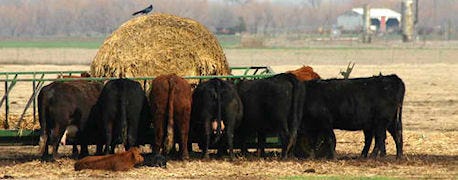February 6, 2014

By Loretta Sorensen
Persistent problems from drought has made feedstuffs more important and their volatility makes it doubly important to push the pencil.
Since there is no "one-size-fits-all" solution to identifying your best possible feed sources, you'll need to analyze all your options, in your location. Because both feed and beef industry markets constantly change, reviewing those feed options several times a year can help you make the most of your resources.
Pricing protein by the pound helps identify the economic details of a protein source, says Dan Childs, agricultural economist at the Samuel Roberts Noble Foundation.

Volatile prices for feed and cattle require constant budgeting and analysis.
"Since many natural source proteins are equally usable by cows, price per pound of protein is a good method to determine the best buy," Childs says. "Making that comparison requires two numbers – the percent of protein in the product and its price per ton."
The total pounds of protein in a ton of feed can be calculated by multiplying the percent of protein in the product by the number of pounds in one ton – 2,000. If alfalfa is 20% crude protein (CP), the number of pounds of protein per ton is equal to .20 x 2,000 = 400.
"If that alfalfa is $180 per ton, the cost per pound of protein would be $180 divided by the 400 pounds, which comes to 45 cents per pound," Childs says. "If 38% cotton seed cake was priced at $320 per ton and you do the math ($320 / (0.38x2000)), you find that the cottonseed cake costs 42 cents per pound. This kind of comparison works well for feedstuffs that are similar in dry matter content."
Childs recommends beef producers approach hay purchases with the same analytical process in order to identify the most economical hay.

Just right: Fecal monitoring is one way to check nutritional balance in cattle. Noble Foundation animal scientists in Oklahoma say this is the ideal manure pat, with consistency similar to thick pancake batter, with a slight divot in the middle.
"In hay purchases you're looking at the cost of protein and TDN (total digestible nutrients)," Childs says. "That analysis requires sampling forage prior to purchase. It's critical to know the analysis and weight of hay bales in order to make prudent purchasing decisions.
"During the most recent drought, there have been several times when alfalfa was the best protein buy," Childs adds. "We also need to be open to trying alternative feed options. Typically, beef producers see alfalfa as a dairyman's feed resource. However, alfalfa could meet the nutritional needs of cows at a lower cost than other feeds."
~~~PAGE_BREAK_HERE~~~
Besides its value as a protein source, alfalfa also provides energy, for example.
Childs recommends beef producers seek the input of a livestock nutritionist competent in beef cattle nutrition when seeking feed analysis data. The nutritionist can select the best combination of feed ingredients to achieve the production goals of a beef cattle producer.
"Price isn't necessarily a good indicator of feed value," Childs says. "You just have to push the pencil. In the process, you can't sacrifice the nutritional requirements of cattle, even for a short period of time. There's a rule of thumb that says you can't starve a profit out of an animal. If you take care of them, they'll take care of you."
Childs adds that evaluating the fecal material of a herd can provide clues to whether cattle are receiving sufficient and/or the right balance of nutrients.
"You may have adequate protein in the diet but be short of energy," Childs says. "Cows grazing pastures can be low on protein. With the kind of drought we've seen recently, forage may lack adequate protein and energy. "
Beef producers who have a thorough understanding of what's inside the feed bags and the bales they purchase are most likely to make the best economic choices concerning their feed alternatives while providing the best possible nutrition for their cattle.
"It's costing more these days to meet nutritional requirements of beef animals," Childs says. "But there's no profit in cutting corners when it comes to nutrition."
Childs encourages beef producers to especially pay close attention to ingredient prices fall. If U.S. corn and soybean farmers harvest the size crop that USDA is forecasting, feed prices could moderate significantly into fall and winter.
"This may not be the year to get in a hurry to contract feed," he says. "The time spent shopping around may pay good dividends."
Sorensen writes from Yankton, S.D.
You May Also Like




